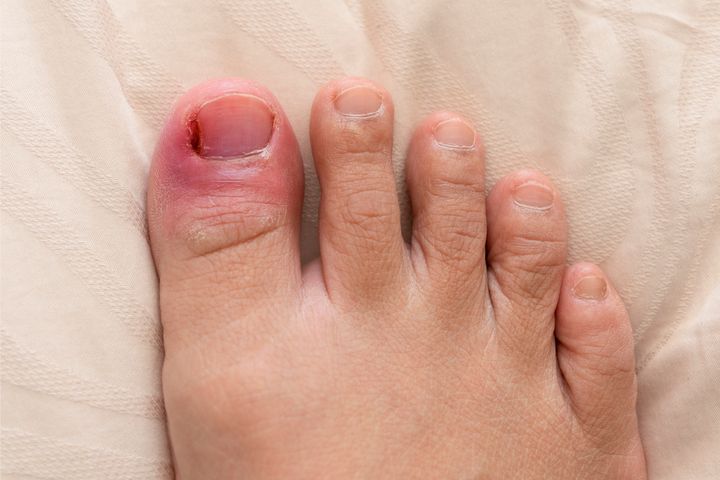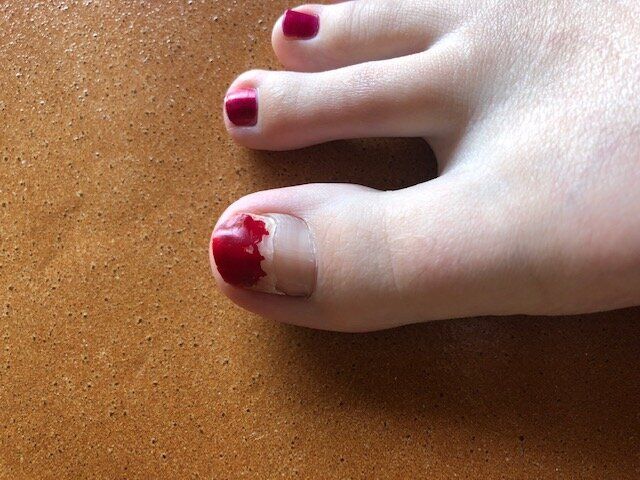
“I’ve had outrageous trouble with my big toenail since I tripped over some loose jeans on the floor in 2014,” says Becky, who ended up damaging her toe and, with that, her toenail.
Since then, Becky – who preferred not to share her surname – has endured agony from an ingrown toenail which, despite the best attempts of medical professionals, is still causing her issues.
“It’s genuinely the thing that troubles me the most in terms of [my] health,” says the 27-year-old, who’s struggled with the issue for six years. “I can’t wear the shoes I want. It can be agony depending on the shoe – I tend to wear loose, fluffy bed socks in the house so the tighter socks don’t irritate it.”
Ingrown toenails are surprisingly common, but they’re not something we chat about often. The issue occurs when the sides of a toenail grow into the surrounding skin causing swelling, redness and discomfort. Other symptoms can include irritation at the nail edge, infections and broken skin.
George Hill, a podiatrist at The Fleet Street Clinic in London, sees a lot of ingrown toenails at his clinic – from simple cases, to toes with severe infections. The same goes for Heena Patel, a podiatrist running two clinics in Pimlico and London Bridge, who sees, on average, 20 patients per week with the issue.
“In lockdown, I have seen those numbers increase, as more people have taken up exercise – especially high impact ones like running and high intensity workouts,” she tells HuffPost UK.
The issue can have a big impact on people’s lives, notes Patel. “The simplest tasks can feel painful, especially if the area around the nail has become so swollen and infected.
“It can deter people from their daily tasks, such as walking or exercise.”
The most common causes are not trimming toenails properly and wearing ill-fitting shoes, but they can also be caused by repetitive stress from intense exercise, genetics, broken nails, and trauma, such as stubbing your toe.
Busting the foot taboos, singer and author Frankie Bridge recently shared snaps of her bandaged toes on Instagram after revealing she’d had surgery for ingrown toenails – a problem she’d struggled with for years.

Becky has had surgery to remove her nail edges but it didn’t get rid of her ingrown toenail, she says, as the nail has grown back wonky.
“I visited so many podiatrists who all trimmed here and there but with short success,” she says. “Then someone stood on my bare foot in their outdoor boots and well... thinking about it now makes me feel a bit faint!”
The 27-year-old has gone up a shoe size to avoid discomfort – and high heels are completely out of the equation as they cause so much pain.
“I recently bought a spin bike and had to stop because the foot cage holder thing was pushing down on my toe and I couldn’t bear the pain,” she admits.
Her plans for doing ballet also fell through because of her feet. “I decided to join adult ballet classes a few years ago, and was desperate to buy pointe shoes and do all the fancy stuff that I never got to as a child. But I couldn’t even put the shoes on without it being agony, so never got the chance.”
Now she’s contemplating getting the whole nail removed, but the thought freaks her out. “I just can’t cope with how gross that will look,” she says.

Currently, her toenail appears to be growing in two layers. “If it wasn’t Covid, I’d try and go back to the GP, but as I’ve already had the minimal treatment done a few times I think they’ll just want to remove the whole thing,” she says. “I can’t bear the thought. I’d never be able to go for a pedicure again.”
How to treat it
The main takeaway is: it probably won’t get better on its own. “I’ve never known a fully ingrown nail to resolve on its own, however some more mild cases may manage to grow out over the skin at the end of the toe,” says Hill.
It’s best to seek professional advice, he adds, as these small issues can turn into infections. You can ask your GP for advice, or go straight to a podiatrist. Each patient and toe is treated differently – the aim is to initially manage the issue with conservative nail treatment, says Hill.
The NHS recommends initially trying at-home remedies like:
soaking your foot in warm water 3 to 4 times a day for a few days – this softens the skin around your toe and stops the nail growing into it
keeping your foot dry for the rest of the day
wearing wide, comfortable shoes or sandals
taking paracetamol or ibuprofen to ease the pain
However if the issue becomes worse, people might require nail surgery or a prescription of antibiotics for the treatment of an infection.
“If left untreated, these infections can track up the foot and become far more of a concern so it’s important to seek professional medical advice from your qualified podiatrist – especially if you’re immunosuppressed,” says Hill. People with diabetes should get any foot worries looked at as soon as possible.
There are two common minor surgical procedures that can be carried out on problematic ingrown toenails: a partial nail avulsion and a full nail avulsion.
Sometimes, just a sliver of the nail can be treated and a bit of the nail can be removed, says Patel. However if the problem is quite acute and deep, then the patient will be advised on a partial nail avulsion, which is essentially nail surgery.
“This involves giving the patient an anaesthetic into the toe and removing the nail spike. The root is then phenolised – phenol is a very strong acid that can ablate the root of the nail so that part of the nail doesn’t grow up again and cause problems,” says Patel.
The other option is where the entire nail is removed and the root of the nail is cauterised using phenol. If phenol is applied, however, the nail won’t grow back.
How to prevent it
Try to wear properly fitted shoes so your toenails have space to breathe and aren’t squashed up against the edges. Keep the toes clean and healthy.
“Cut toenails straight across and leave a free edge so you’re not cutting them too short and too close to the skin,” says Patel, “as this can encourage the nails to grow into the skin.”